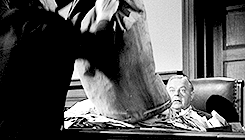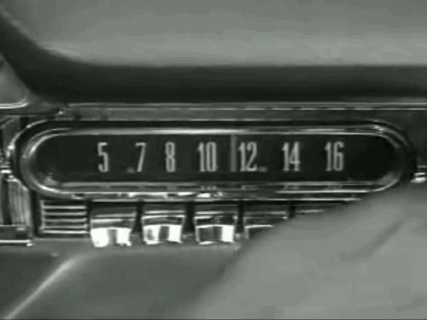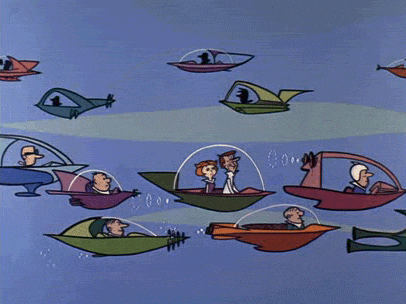Distance education is any learning that happens remotely; the student is in one place and the professor is in another. These days, most courses taught at a distance are online classes. They make use of cutting-edge technology, such as webinars, podcasts, and exams proctored via webcam, to help students master the curriculum.
Because we’re so spoiled by these innovations, it’s hard to imagine any distance education course that doesn’t use the internet, but distance education is nearly 300 years old. It’s always adjusted to the technology of the era, so it’s not surprising that these classes took place by mail, radio, and film before they made their way to the internet.

Giphy
Correspondence Classes
The first known distance education course was offered way back in 1728, when a Boston man began mailing weekly lessons to students. It was a one-way system, however. The students read and completed the lessons if they so desired and never had to turn in any assignments for grading.
That changed in 1837 when a new correspondence course promised to teach a system of shorthand for writing the English language. The instructor, Isaac Pitman, mailed tutorials to students, and they completed assignments and sent their work back to him for feedback and review.
To us, these early classes seem laughable—just imagine how long they took in the age of snail mail! Plus, it’s not hard to believe that some students claimed their assignments got “lost in the mail,” but those correspondence courses were actually extremely popular in their time.
By 1858, the University of London had started its External Programme, which offered degrees that could be earned entirely by completing correspondence coursework. Fifteen years later, a woman in Boston opened a school, not just a program, that was devoted to correspondence learning. The Society to Encourage Studies at Home marketed itself to women (specifically wives and mothers who spent much of their time at home), encouraging them to pursue knowledge in their free time. This was just the beginning. Other correspondence programs and schools followed in suit.
Film and Radio Classes
Most U.S. students who were in school any time after the early 1940s have seen educational movies or films for class. Substitute teachers in high schools may wheel out outdated television sets to show lectures, and college professors might recommend certain Youtube videos related to the curriculum. This is nothing new.

Giphy
There was a time, however, when radio and television were innovations that appealed to schools that hoped to expand their distance learning programs and pave the way for the future.
In the 1930s, the Federal Communications Commission (FCC) and the Association of College and University Broadcasting Stations were founded. Their missions? To reserve certain radio frequencies for educational broadcasting. The University of Louisville was one of the first colleges to capitalize on their endeavors. In 1948, it developed a plan to broadcast live lectures from campus to local students who wanted to receive college credit in exchange for a small fee.
Radio was quickly replaced with television, and the FCC soon began reserving certain TV stations for educational programming, much as it had done with radio. The City Colleges of Chicago were quick to adapt. In 1951, they organized a program that granted degrees to students who completed all of their coursework by watching broadcast lectures. This was the first of many telecourses, and soon, colleges across the nation were developing their own. As time passed, these courses were recorded so that students could watch them at their convenience from VHS tapes and CD-ROMs. Eventually, they made their way to the internet.
Online Classes
Correspondence classes, educational radio broadcasts, and telecourses represent a demand for distance learning that has spanned hundreds of years, and the internet has been a successful next step. It’s difficult to trace the emergence of the first online classes, though, because of the huge technological boom of the 1980s and 1990s. Multiple universities and research institutions were simultaneously developing their own internet platforms and software for online quizzes, lessons, and videos. Several different schools claim to be the originators of online coursework, but it’s hard to say. What is certain is that these classes developed quickly. For perspective, the University of Phoenix, now a well-known online college, was founded as a college for working adults in 1976 and began offering online classes in 1989.
Since then, online classes have sharpened.

The Jetsons / Giphy
There are multiple options, and students can decide if they’d like to log in at a specific time each week or at their convenience. Courses are evaluated differently, and some have deadlines while others do not. They may or may not use live and/or recorded lectures, message boards, chat functions, podcasts, presentation software, and much more. For more information about the current state of online learning, check out Student Caffé’s information.
What’s Next?
The future of distance education is unknown, but it’s not likely to become less popular any time soon. If the past is any indication, distance education will do just fine because it willingly adapts to current technology.
-
The History of Higher Ed for Students Who Are Hard of Hearing or Deaf
-
The History of Historically Black Colleges and Universities
-
Environmental Education and Sustainable Schools
-
The TRIO Programs
-
Vocational Education from the 1900s to Today
-
The Reality of New York State’s Free College Education Bill
-
Co-Ed and Gender-Neutral Housing from the 1960s to Present

